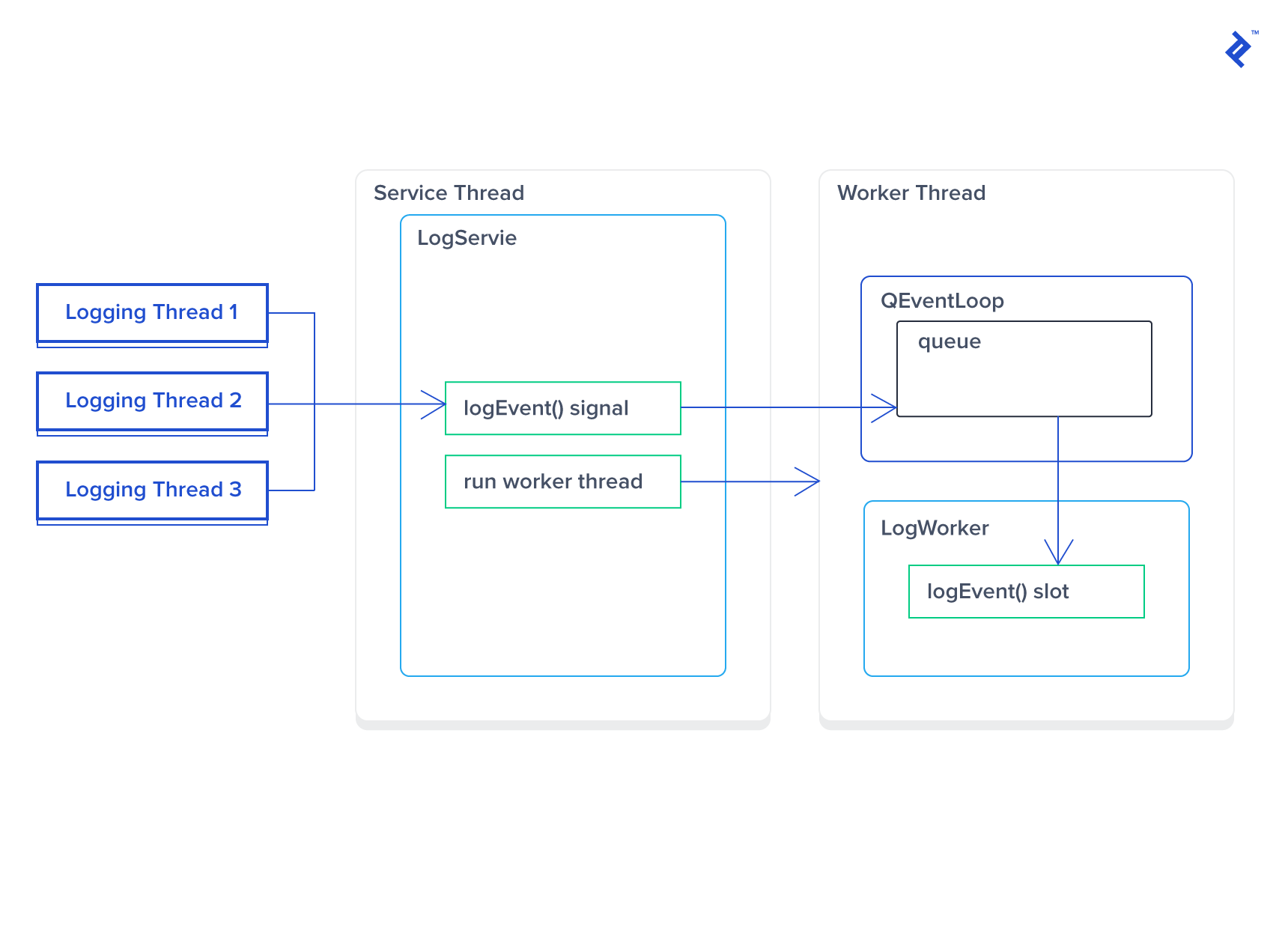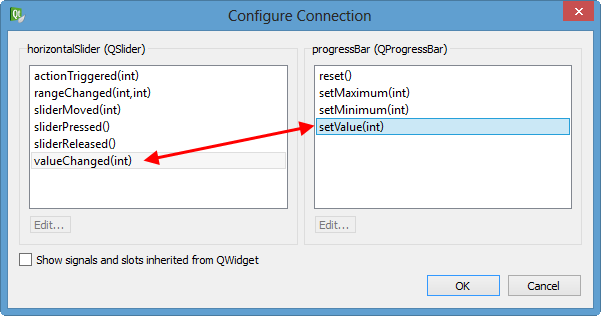(Qt) Signals and Slots. #include /. What Signals and slots Description The moc that connects objects Why Inter-object communication Exmaple Simple example of signals and slots look at MOC /home /rootshell/Code/Qt. SetInterval (3000); //Connect the two objects connect (& mtimer, & QTimer:: timeout, this. Home Qt Development General and Desktop How to handle a QTimer from another Thread in the MainWindow Class with a Connection and Signal and Slot -QueuedConnection. Qtを使い始めたとき、SIGNAL-SLOTの使い方でまず躓きました。 pushButtonだと、スロットを登録すると勝手に関数を作ってくれて、 ボタンが押されたらこの関数が自動的に呼ばれるのだな、 ということがすぐわかり初心者でも作るのが簡単でした。 やりたいこと 現在時刻を1000ms毎に表示する.
Introduction
Remarks

Official documentation on this topic can be found here.
A Small Example
Signals and slots are used for communication between objects. The signals and slots mechanism is a central feature of Qt and probably the part that differs most from the features provided by other frameworks.
The minimal example requires a class with one signal, one slot and one connection:
counter.h

The main sets a new value. We can check how the slot is called, printing the value.
Finally, our project file:
The new Qt5 connection syntax
The conventional connect syntax that uses SIGNAL and SLOT macros works entirely at runtime, which has two drawbacks: it has some runtime overhead (resulting also in binary size overhead), and there's no compile-time correctness checking. The new syntax addresses both issues. Before checking the syntax in an example, we'd better know what happens in particular.
Let's say we are building a house and we want to connect the cables. This is exactly what connect function does. Signals and slots are the ones needing this connection. The point is if you do one connection, you need to be careful about the further overlaping connections. Whenever you connect a signal to a slot, you are trying to tell the compiler that whenever the signal was emitted, simply invoke the slot function. This is what exactly happens.
Here's a sample main.cpp:
Hint: the old syntax (SIGNAL/SLOT macros) requires that the Qt metacompiler (MOC) is run for any class that has either slots or signals. From the coding standpoint that means that such classes need to have the Q_OBJECT macro (which indicates the necessity to run MOC on this class).
The new syntax, on the other hand, still requires MOC for signals to work, but not for slots. If a class only has slots and no signals, it need not have the Q_OBJECT macro and hence may not invoke the MOC, which not only reduces the final binary size but also reduces compilation time (no MOC call and no subsequent compiler call for the generated *_moc.cpp file).
Connecting overloaded signals/slots
While being better in many regards, the new connection syntax in Qt5 has one big weakness: Connecting overloaded signals and slots. In order to let the compiler resolve the overloads we need to use static_casts to member function pointers, or (starting in Qt 5.7) qOverload and friends:
Multi window signal slot connection
A simple multiwindow example using signals and slots.
There is a MainWindow class that controls the Main Window view. A second window controlled by Website class.
The two classes are connected so that when you click a button on the Website window something happens in the MainWindow (a text label is changed).
I made a simple example that is also on GitHub:

mainwindow.h
mainwindow.cpp
website.h
website.cpp
Odds in roulette. Project composition:
Consider the Uis to be composed:
- Main Window: a label called 'text' and a button called 'openButton'
- Website Window: a button called 'changeButton'
So the keypoints are the connections between signals and slots and the management of windows pointers or references.
Qt Qtimer Signal Slot Car Racing

In QT5, we have a special timer class, QTimer. We can use it to complete some timing operations. Examples are as follows:
At the end of our timer, we need to stop the timer manually, otherwise it will send out the timeout signal continuously. At the same time, we need to note that before making the connection function, we need to have an instance of the timer, otherwise it will cause the program to crash. Of course, we can use the static method of QTimer instead of instantiating the timer to start the timer directly Here is an example of a QT document:
We can use multiple timers in a program. Each timer has its own timer ID, which is similar to the pid of window process. We can use timer event to process multiple timers
reference resources: QTimer timer
The idea of program design is as follows
- Set the timing period first
- Bind the timeout() signal to the custom slot function
- Call the start function to start the timer
Why gambling should not be legalized as a. The following is the definition in the widget window class:
In this paper, a QTimer is defined, and the slot function onTimeOut() is defined as the slot function corresponding to the timeout signal.
Qt Signal Slot Thread
The code in the constructor of the window class is as follows:
In this example, the timing period of the timer is set to 1s, then the signal is bound to the slot, and finally the timer is started.
The code in the timer processing function is as follows:

Official documentation on this topic can be found here.
A Small Example
Signals and slots are used for communication between objects. The signals and slots mechanism is a central feature of Qt and probably the part that differs most from the features provided by other frameworks.
The minimal example requires a class with one signal, one slot and one connection:
counter.h
The main sets a new value. We can check how the slot is called, printing the value.
Finally, our project file:
The new Qt5 connection syntax
The conventional connect syntax that uses SIGNAL and SLOT macros works entirely at runtime, which has two drawbacks: it has some runtime overhead (resulting also in binary size overhead), and there's no compile-time correctness checking. The new syntax addresses both issues. Before checking the syntax in an example, we'd better know what happens in particular.
Let's say we are building a house and we want to connect the cables. This is exactly what connect function does. Signals and slots are the ones needing this connection. The point is if you do one connection, you need to be careful about the further overlaping connections. Whenever you connect a signal to a slot, you are trying to tell the compiler that whenever the signal was emitted, simply invoke the slot function. This is what exactly happens.
Here's a sample main.cpp:
Hint: the old syntax (SIGNAL/SLOT macros) requires that the Qt metacompiler (MOC) is run for any class that has either slots or signals. From the coding standpoint that means that such classes need to have the Q_OBJECT macro (which indicates the necessity to run MOC on this class).
The new syntax, on the other hand, still requires MOC for signals to work, but not for slots. If a class only has slots and no signals, it need not have the Q_OBJECT macro and hence may not invoke the MOC, which not only reduces the final binary size but also reduces compilation time (no MOC call and no subsequent compiler call for the generated *_moc.cpp file).
Connecting overloaded signals/slots
While being better in many regards, the new connection syntax in Qt5 has one big weakness: Connecting overloaded signals and slots. In order to let the compiler resolve the overloads we need to use static_casts to member function pointers, or (starting in Qt 5.7) qOverload and friends:
Multi window signal slot connection
A simple multiwindow example using signals and slots.
There is a MainWindow class that controls the Main Window view. A second window controlled by Website class.
The two classes are connected so that when you click a button on the Website window something happens in the MainWindow (a text label is changed).
I made a simple example that is also on GitHub:
mainwindow.h
mainwindow.cpp
website.h
website.cpp
Odds in roulette. Project composition:
Consider the Uis to be composed:
- Main Window: a label called 'text' and a button called 'openButton'
- Website Window: a button called 'changeButton'
So the keypoints are the connections between signals and slots and the management of windows pointers or references.
Qt Qtimer Signal Slot Car Racing
In QT5, we have a special timer class, QTimer. We can use it to complete some timing operations. Examples are as follows:
At the end of our timer, we need to stop the timer manually, otherwise it will send out the timeout signal continuously. At the same time, we need to note that before making the connection function, we need to have an instance of the timer, otherwise it will cause the program to crash. Of course, we can use the static method of QTimer instead of instantiating the timer to start the timer directly Here is an example of a QT document:
We can use multiple timers in a program. Each timer has its own timer ID, which is similar to the pid of window process. We can use timer event to process multiple timers
reference resources: QTimer timer
The idea of program design is as follows
- Set the timing period first
- Bind the timeout() signal to the custom slot function
- Call the start function to start the timer
Why gambling should not be legalized as a. The following is the definition in the widget window class:
In this paper, a QTimer is defined, and the slot function onTimeOut() is defined as the slot function corresponding to the timeout signal.
Qt Signal Slot Thread
The code in the constructor of the window class is as follows:
In this example, the timing period of the timer is set to 1s, then the signal is bound to the slot, and finally the timer is started.
The code in the timer processing function is as follows:
reference resources: Qtimer of Qt